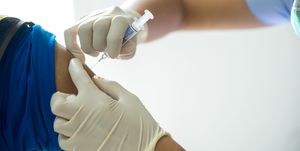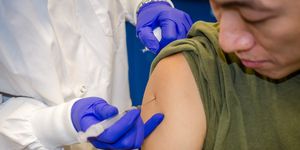What Happened When I Signed Up for the AstraZeneca Vaccine Trial

I was standing outside the fence at my son’s one and only swimming meet—watching through the wrought-iron bars as the swimmers raced two at a time with an open lane between them—when I heard that University of Wisconsin Hospital was seeking volunteers to test the AstraZeneca Vaccine (AZD1222). It was a few days before school started, which would be online, and after months of social distancing, no-contact delivery, countless virtual meetings, and swabs probing into the gray matter of my lower brain to test for COVID, I was starting to feel a little desperate for anything that might facilitate a return to normal life. Even if it meant donating my body to science. I signed up as soon as I got home.
Similar to the other major vaccines in the news—most notably the Pfizer and Moderna medications—AZD1222 uses a double-injection, or two-shot, protocol. The Pfizer and Moderna vaccines differ from the AstraZenenca drug in that they use messenger RNA to signal cells to make a “virus spike protein,” which the immune system recognizes as foreign and learns to attack. Instead of mRNA, the AstraZeneca vaccine delivers the spike protein by way of an adenovirus, a weakened version of the common cold. In all three cases, the first shot revs the immune system and the second shot, a month later, boosts the body’s virus-fighting engine into high gear.
What about side effects?
The AZD1222’s possible side effects include pain, mild fever, chills, muscle aches, headache, and fatigue—all signs the immune system is turning on. I wasn’t overly worried about them, nor did I buy into the rumors that the vaccine would be used to Trojan horse government tracking devices. I’d lost the twenty pounds I’d gained during the first months of the quarantine, I swam five days a week, and with no underlying health conditions, I believed I’d be able to weather the storm if the vaccine failed and I ended up getting sick. And since my wife worked for the health system running the trial, and had a number of colleagues who’d already volunteered as guinea pigs, I had had faith in the study’s integrity. In fact, as a healthy, active man, I felt a duty to pony up to help end the pandemic. Plus, if a tracking device were somehow implanted, maybe my sense of direction when driving would improve.
A rocky start
But as soon I signed up, the trial screeched to a halt. A week after I completed the screening questionnaire, AstraZeneca announced it was pausing the trial after two participants in the U.K. experienced symptoms of transverse myelitis, an inflammation of the spinal cord. An independent committee needed review the data before study could resume. I was glad for the safety protocols, but I confess I felt like a delayed airline passenger stuck in an airport. The endless waiting around seemed worse than the possibility of crashing.
Six weeks later, when the trial re-started, I once again filled out the screening questionnaire and, this time, was able to schedule an appointment. I was pulling into the parking garage when the news announced that the Pfizer vaccine had been approved in the U.K. Health and Human Services Secretary Alex Azar predicted that emergency approval in America would be coming in the next week. Health care workers and the elderly were first in line, and the vaccine would roll out to the rest of the country over the coming months. Participating in the AZD1222 study wouldn’t disqualify me from getting another vaccine—a good thing since there was a 1 in 3 chance I’d be getting a placebo instead of the actual medication. The study was “double blind,” meaning that not even the physicians administering the trial knew which volunteers got the good stuff.
What happened on injection day
A research coordinator met me in the hospital’s lobby. She knew my name and, strangely, had no trouble picking me out amongst the traffic of patients and staff crossing through the room. We couldn’t shake hands, so we nodded in our masks and I followed her deep into the hospital’s interior to an elevator I never would have found on my own. I was led into an exam room, my first of three, where I answered a long series of questions about my medical history. The trial was voluntary, and I could quit any time, but if I stayed in, the study would last two years. I’d be given injections today and again on Day 29, have blood drawn both times, as well as on Days 57, 90, 180, 360, and 730, and would conduct follow-up interviews by phone and email in the meantime. “That all sound okay?” the research assistant asked me.
“I’ve come this far,” I said, giving her a thumb’s up.
“Good,” she said. She punched in a code on a small metal box. For a moment I thought she was retrieving my shot. Instead, she handed me a small brown envelope with a crisp hundred-dollar bill inside.
“I get paid?” I asked. I hadn’t expected to receive a dime.
She nodded. “Just a little. It’s sort of buried in the consent forms.”
“Score,” I said. I slid the bill inside my wallet.

Another elevator led me to another exam room, this time with a view of Lake Mendota. It was a blue, windy day and the lake was wrinkled with white-capped waves. A pair of nurses worked in tandem to check my vital signs, draw my blood, and administer a final COVID-19 test. The nurse slid the swab so far inside my nose I felt my eyes go crossed. After a quick physical from the doctor—no pants around the ankles, no turn and cough—I was led across the hall to my final room, this time full of recliners. This where I’d, at last, get my shot in the arm.
I rolled my sleeve above my shoulder. “I just hope I get the real deal,” I said to the nurse. “I don’t want the placebo.”
“You’ll know if you get it,” said a man’s voice behind a curtain. He was another volunteer. “My buddy’s an immunologist at Harvard. He says you’ll be able to tell if you really got it.”
“Will my pee turn blue?” I asked.
He laughed. “You’ll feel like you’ve caught a cold.”
A few minutes later
For the first time in my life, I actually wished for a stuffy nose—for any sign that would confirm the presence of the actual vaccine. In addition to furthering the cause of science, I was excited about the possibility of being among the protected. Of putting the pandemic behind us.
After the nurse administered our shots, we were required to wait twenty minutes to ensure against adverse or allergic reactions. I leaned my head against the chair. A moment later, the guy spoke up again. “I have a good feeling,” he said.
“Yeah?”
“I think so,” he said. Then, “What are you going to do when this is over? You know, once we can go back to normal?”
“I’m thinking dinner party,” I said. “Lots of friends. Lots of food. How about you?”
“Concerts,” he said. “I caught thirty-four shows in 2019. I’d planned to go to even more this year, before all hell broke loose. Live music, man. It’s the stuff of life.”
“I wouldn’t mind a ball game,” I said. I imagined sitting in the stands with my sons, hot dogs on our laps.
“Oh, God, football,” he said. He let out a little hum. “There’s so much to look forward to.”
Seven days in, I’ve yet to feel a thing, other than a little soreness where the injection went in. Earlier tests have shown that AZD1222 is most effective when a half dose is given first, followed by a full dose in the second round. So I’m keeping my fingers crossed that in three more weeks, I’ll wake up with a mild fever, maybe a few aches and pains. Just a little misery to know the vaccine is working.
Here’s hoping.
Source: Read Full Article

